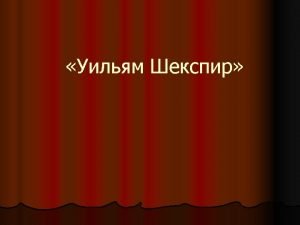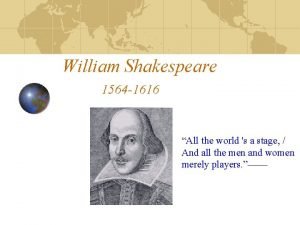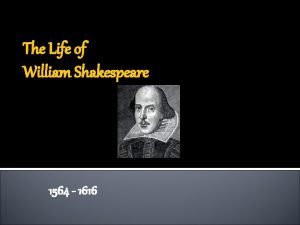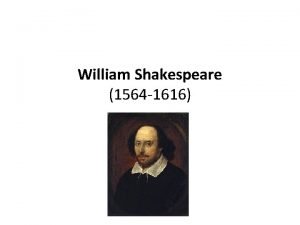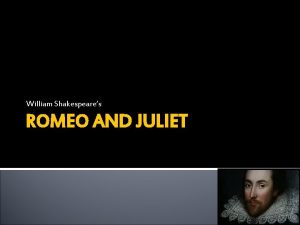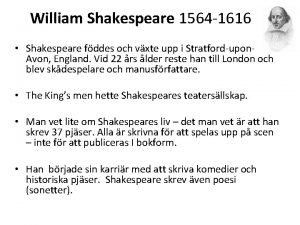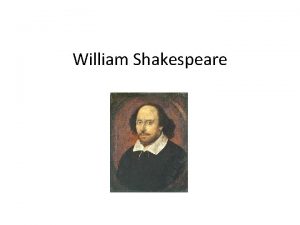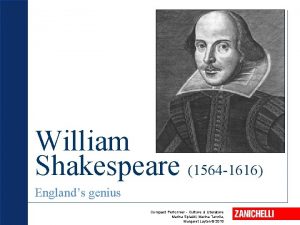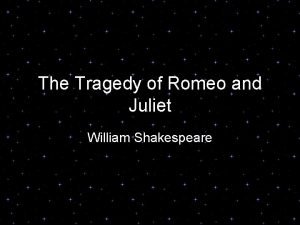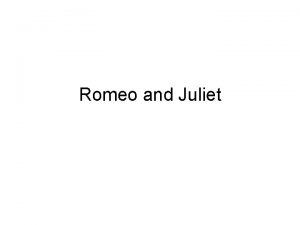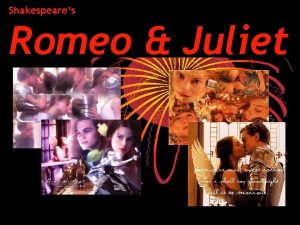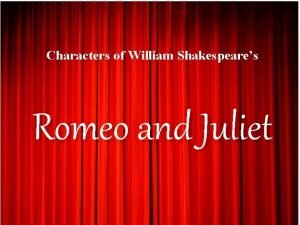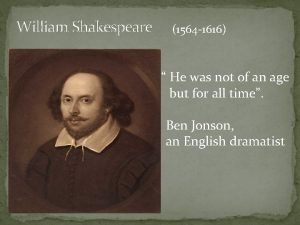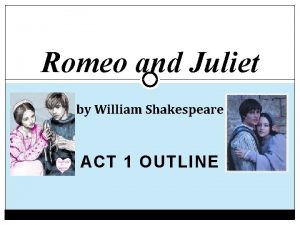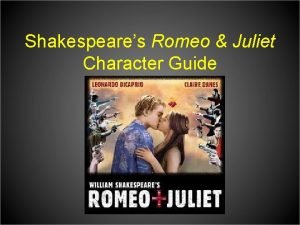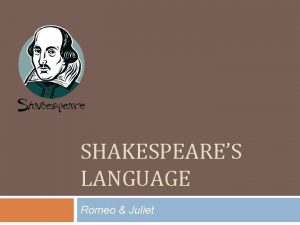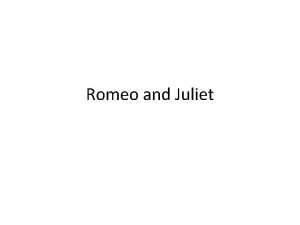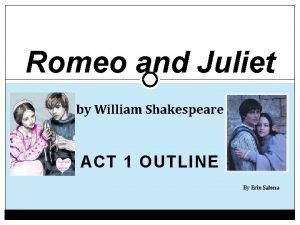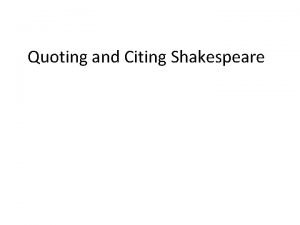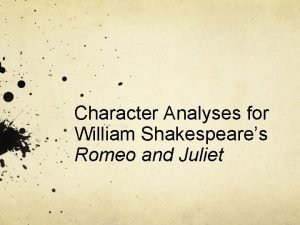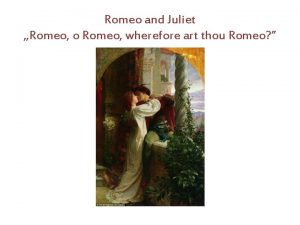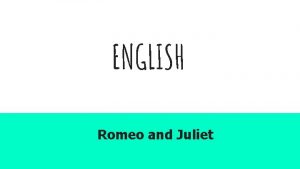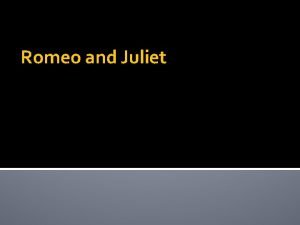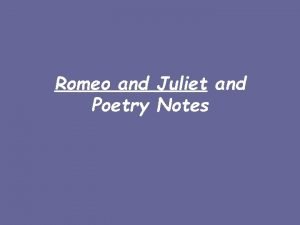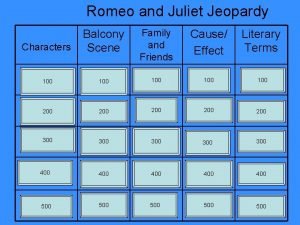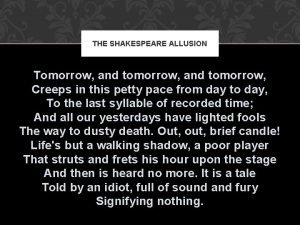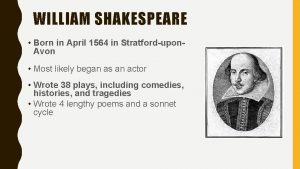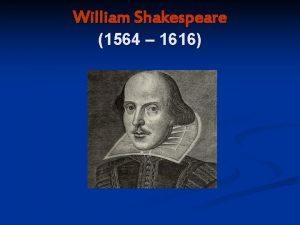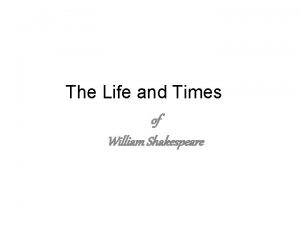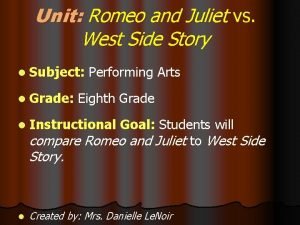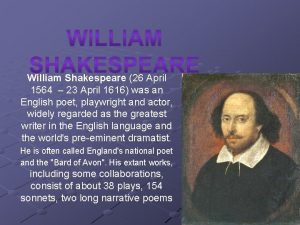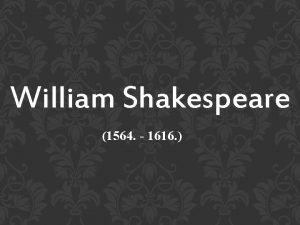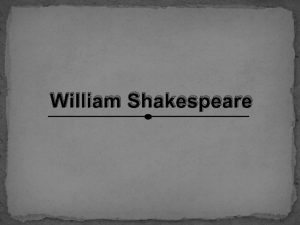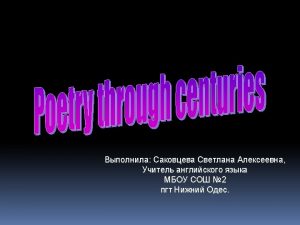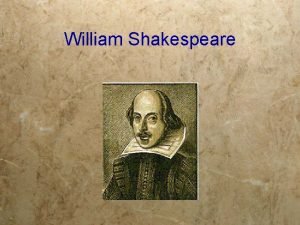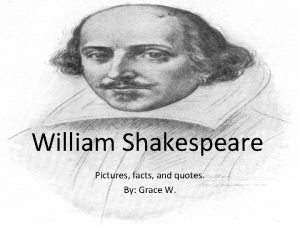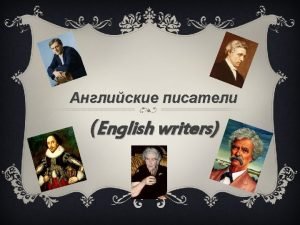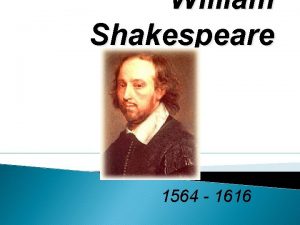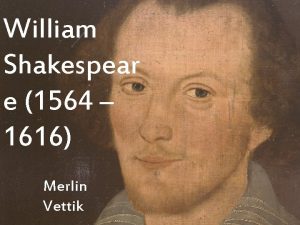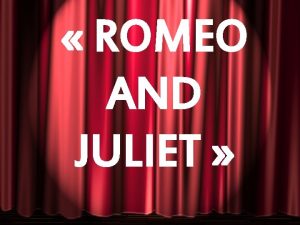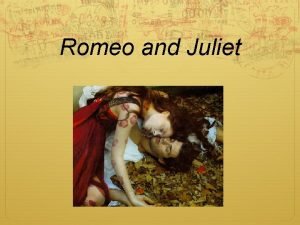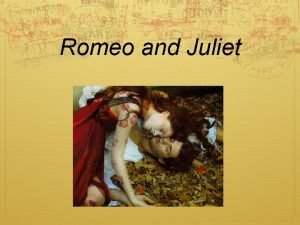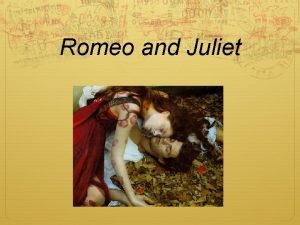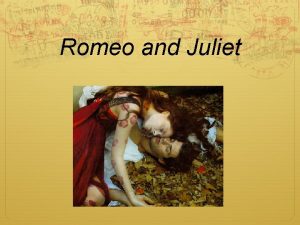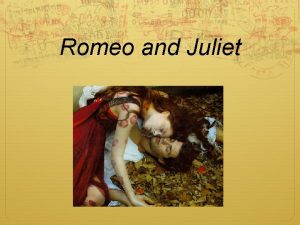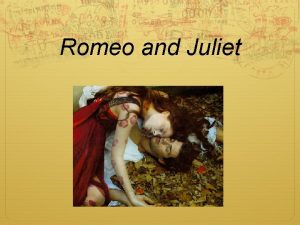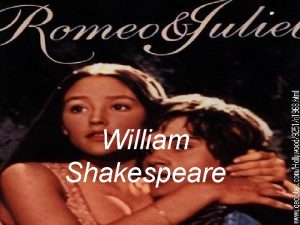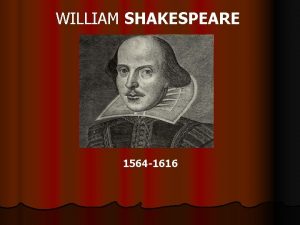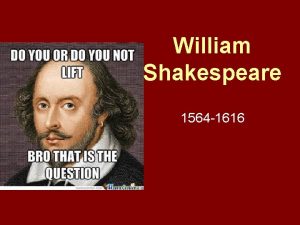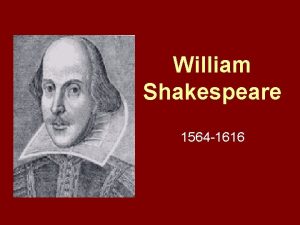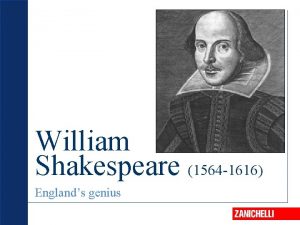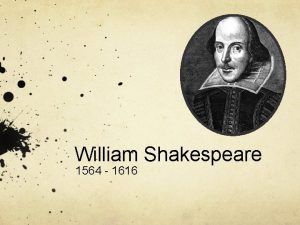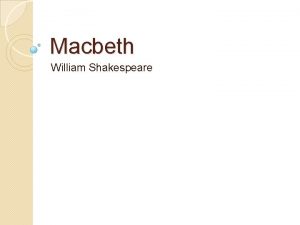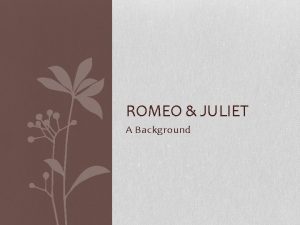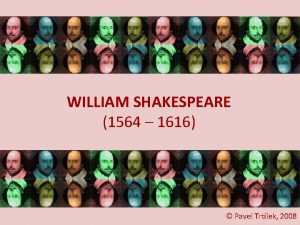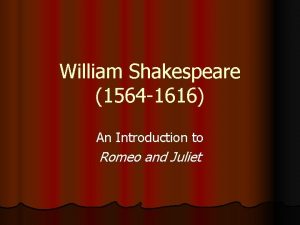William Shakespeare 1564 1616 Romeo and Juliet 1595



















































- Slides: 51

William Shakespeare 1564 -1616

Romeo and Juliet 1595

The Globe Theatre

Blank verse The poetry is largely written is both prose and poetry. The word blank verse means there is no rhyme. A line is written in what is called iambic pentameter when an unstressed syllable is followed by a stressed syllable.

Iambic Pentameter Iambic pentameter simply means that there are five of these iambic units in each line. Five strong beats are per each line. But soft! What light through yonder window breaks?

Couplets When Shakespeare uses rhymes, he generally uses couplets, two consecutive lines of poetry that rhyme. The couplets often punctuate a character’s exit or signal the end of a scene (or a sonnet). Good night, good night! Parting is such sweet sorrow That I shall say good night till it be morrow.

Context The time period in which Shakespeare lived—Elizabethan England, named for the queen— influenced the content of his plays as well as the way in which they were performed. Elizabethans believed the earth was flat.

The Four Humors In Elizabethan times, people believed that a person’s mental, physical, and emotional state were determined by the balance of the four “humors” in the body: blood, yellow bile, phlegm and black bile. They believed the humors gave off vapors that affected the brain, so whatever humor dominated would determine your personality type.

Marriage In Shakespeare’s day, marriages were generally contracts set up by the parents. When Juliet’s parents arrange a marriage for her, it seems strange to us; Shakespeare’s audience would have thought it was completely normal.

Tragedy Shakespeare’s tragedies also follow a pattern that would have made sense to his audience. Elizabethans believed that people’s decisions and mistakes always had consequences, and that people sometimes had to pay a high price for their mistakes. In Shakespeare’s tragedies, the main characters make decisions that upset the proper order of their world and so affect them and everyone around them. The situation is resolved only when others learn lessons from the main characters’ deaths.

Why we read… So why do we still read plays like Romeo and Juliet? When Shakespeare’s world was so different from ours, what can we learn from his plays? Well, the plays are not only great, powerful stories—they also teach lessons about life that apply to people in all cultures and time periods, and those lessons can help us when we come across hard times in our own lives.

Keep in Mind: Don’t be alarmed by the old-fashioned language: this is really a play about people who are a lot like us, and the difficult words, when you look at them carefully, express emotions anyone can understand. And remember, the play is POETRY: it’s not supposed to be written exactly the way people talk. The poetry is part of what makes it beautiful and powerful—and worth reading.

Reading the Play Shakespeare’s plays were meant to be performed—they were some of the most popular entertainment of their time. So when we read the play, the point is to try and imagine it happening onstage! Because of the minimal props and scenery, the action in Shakespeare’s plays had to be conveyed through words and conversations. A conversation between characters is called DIALOGUE. Two things to know: Sometimes a character will give a long speech all by herself, revealing her secret thoughts to the audience: this is called a soliloquy. Sometimes a character will just make a brief comment to the audience that the other characters don’t hear; this is called an aside.

So Who’s Who Here? Shakespeare’s plays can have LOTS of characters. Let’s try to get them straight in our minds… First of all, all of the characters in Romeo and Juliet are arranged around a central conflict between two rival families: the Montagues and the Capulets.

The Montagues Romeo Montague Romeo’s Dad Lady Montague Romeo’s mother Mercutio Romeo’s best friend Benvolio Romeo’s cousin

The Capulets juliet Capulet Juliet’s father Lady Capulet Juliet’s Mother Tybalt Nurse Juliet’s cousin Juliet’s nanny

And finally… One other “character”: The Chorus is not a part of the action, but a speaker who comes onstage to make comments on the action. The Chorus is kind of like a TV announcer in contemporary life —as far as the characters know, the chorus doesn’t exist, but he helps explain things to us.

Summary Romeo and Juliet is a story about two teenagers who fall in love but are forbidden to see each other by their parents. They meet one night at a party (Romeo is actually there to check out another girl, Rosaline) and quickly fall in love. Unfortunately, Juliet’s parents already have a husband picked out for her. So, the two decide to get married and enlist the help of Juliet’s nurse to act as a messenger between the two and Friar Laurence who agrees to marry them. However, plans go awry after Romeo is banished from Verona and doesn’t get filled in on the plans that Juliet has for them to live happily ever after…

Setting The story is set in the late 1500’s mostly in the town of Verona, Italy. However, there a few acts set in Mantua, Italy a smaller town just a few miles away

Timeline Sunday – Act One Monday – Act Two Tuesday – Act Three Wednesday – Act Four Thursday – Act Five

The Feud Romeo’s family, the Montagues, have a long standing feud with Juliet’s family, the Capulets. While the audience never learns about the source of the ancient quarrel, we do learn that it has recently grown stronger.

Comedy and Tragedy Romeo and Juliet begins as a comedy but ends as a tragedy Elements of a comedy Elements of a tragedy • A struggle of young lovers to overcome difficulty that is often presented by elders • Must have a tragic hero/heroine • Ends in the death of many of the main characters • Separation and unification • Heightened tensions, often within a family The shift from comedy to tragedy is what sets Romeo and Juliet apart from the rest of Shakespeare’s plays

Themes Love • The power of love • Love as a cause for violence Hate • Hate as a forced emotion Fate • The inevitability of fate • Family/Adult Intervention

Writing Style Parts of Romeo and Juliet are written as a sonnet, a poem of 14 lines written and rhymed in iambic pentameter. Each sonnet ends with a couplet. In a Shakespearean sonnet the rhyme scheme is ABAB CDCD EFEF GG A couplet is two consecutive lines that rhyme. Iambic pentameter refers to the rhythm of each line. It is an unstressed syllable followed by a stressed one. “Bŭt sóft! Whăt líght throŭgh yóndĕr wíndŏw bréaks? ”

Plagiarism!? Shakespeare did not invent the story of Romeo and Juliet. A poet named Arthur Brooks wrote the story of Romeus and Juliet as a long poem that was itself not original, but rather an adaptation of adaptations that stretched across nearly a hundred years and two languages. Many of the details of Shakespeare’s plot are taken directly from Brooks’ poem, including the meeting of Romeo and Juliet at the ball, their secret marriage, Romeo’s fight with Tybalt, the sleeping potion, and the timing of their suicides.

Interesting… The Italian city of Verona, where Romeo and Juliet lived, receives about 1, 000 letters addressed to Juliet every Valentine's Day. “Star-crossed lovers” refers to two people who are in love but have conflicting astrological signs. In Shakespeare’s times, people believed the course of their lives was determined by the exact second they were born.

Verona Today, Verona has an incredible amount of graffiti, which is legal, provided that you are writing about your love for someone.

Shakespeare Literary Terms Drama: a story written to be acted for an audience Tragedy: a play, novel, or other narrative that depicts serious and important events in which the main character comes to an unhappy end

Sonnet: fourteen-line lyric poem that is usually written in iambic pentameter and that has one of several rhyme schemes Shakesperean: 3 four-line units or quatrains, followed by a concluding two-line unit or couoplet (abab, cdcd, efef, gg) Prologue: a short introduction at the beginning of a play that gives a brief overview of the plot

Prose: direct, unadorned form of language, written or spoken, in ordinary use Chorus: a group who says things at the same time • Anachronism: event or detail that is inappropriate for the time period

The Ironies Verbal irony: a writer or speaker says one thing, but really means something completely different Dramatic irony: the audience or reader knows something important that a character in a play or story does not know

Monologue: a speech by one character in a play Soliloquy: an usually long speech in which a character who is on stage alone expresses his or her thoughts aloud

Oxymoron: a combination of contradictory terms (ex. Jumbo shrimp) Foil: character who is used as a contrast to another character; writer sets off/intensifies the qualities of 2 characters this way Scar and Simba are foil characters in the Lion King.

• Aside: words that are spoken by a character in a play to the audience or to another character but are not supposed to be overheard by the others on stage • Pun: a play on the multiple meanings of a word, or on two words that sound alike but have different meanings

Static character: a character who does not change much in the course of a story Comic relief: humor added that lessens the seriousness of a plot

Dynamic character: character who changes as a result of the story’s events Blank (“unrhymed” – no rhyme at the end of lines) Verse: poetry written in unrhymed iambic pentameter; each line of poetry contains 5 iambs, or metrical feet, that consist of an unstressed syllable followed by a stressed syllable

Couplet: two consecutive lines of poetry that rhyme; couplets often signal the EXIT of a character or end of a scene

I. Biography Born in 164 Died April 23, 1616 (rumored to be his birthday) Thought to have attended Stratford Grammar school (he left school at the age of 15 and never pursued further formal education)

Married Anne Hathaway at the age of 18 (she was 8 years older) 1. She gave birth to his first daughter six months later 2. Two years later they had twins (one of which was a son who died at eleven) 3. Five years after his marriage to Anne Hathaway Shakespeare moved to London

Began working at the Globe Theatre He first appeared as a poet in 1593 with “Venus” and “Adonis” 36 of Shakespeare’s 38 plays were published in the 1 st Folio of 1623 Retired in 1611 and moved back to Stratford

Buried in the Church of the Holy Trinity in 1616 Died after an evening’s drinking with some theatre friends Gravestone says: “Good friend for Jesus sake forebeare, to dig the dust encloased heare, blste be ye man yt spares these stones, and curst he yt moves my bones Bard of Avon = poet of Avon

II. Shakespeare’s World A. Elizabethan Age 1. Queen Elizabeth I 2. Great Virgin Queen/ruled 1558 -1603 B. Age of Discovery 1. Pursuit of scientific knowledge and the exploration of human nature 2. Assumptions concerning feudalism openly challenged (optimism concerning humanity)

D. The Reformation 1. England is a Protestant/Anglican country 2. Continuous religious strife C. Shakespeare’s works deal with civil harmony, either restoring or maintaining it 1. War of the Roses (Lancaster v. York) 3. Queen Margaret/”Bloody Mary” = Catholic sister of Elizabeth)

E. The Renaissance 1. The cultural rebirth of Europe (14 th-17 th centuries) 2. Based on the rediscovery of the literature of Greece and Rome 3. Music of Shakespeare = Baroque A. Strings, woodwinds and brass B. Vivaldi, Bach, Handel, Corelli

III. The Globe A. Shakespeare’s Globe Theatre was built in 1598 in the Bankside district of London B. Open-air octagonal amiptheater that could seat up to 3000 C. All shows occurred during the day (no lighting) D. No scene changes (props and costumes used)

E. The “pit” is the floor surrounding the stage where “one-penny” spectators stood F. Brought together social elite and common drunks

G. “Principal Actors” Richard Burbage – most significant tragedian of Elizabethan stage Initiated performances of “Hamlet, Lear, and Othello” Shakespeare wrote many tragic hero roles with Burbage in mind

Will Kemp – leading comic actor Shakespeare as an actor – do not overestimate, playwright and producer take precedence

H. 1613 The Globe Theatre burned down Thought to be caused by a canon in a performance of Henry VII

I. New Globe built and operated until 1542 1. Puritans closed it down 2. 1644 the Globe was torn down by Cromwell’s orders and tenements were constructed

J. The new Globe Theatre opened in May 1997 by Queen Elizabeth II
 William shakespeare 1564 to 1616
William shakespeare 1564 to 1616 William shakespeare 1564 to 1616
William shakespeare 1564 to 1616 William shakespeare 1564 to 1616
William shakespeare 1564 to 1616 William shakespeare 1564 to 1616
William shakespeare 1564 to 1616 Onomatopoeia in romeo and juliet
Onomatopoeia in romeo and juliet 1564-1616
1564-1616 Dramski trikotnik hamlet
Dramski trikotnik hamlet William shakespeare's timeline
William shakespeare's timeline 1564 to 1616 england timeline
1564 to 1616 england timeline Old english timeline
Old english timeline On april 23 1564 william shakespeare was born
On april 23 1564 william shakespeare was born Juliet
Juliet The tragedy of romeo and juliet by william shakespeare
The tragedy of romeo and juliet by william shakespeare Romeo and juliet by william shakespeare summary
Romeo and juliet by william shakespeare summary Who wrote romeo and juliet
Who wrote romeo and juliet Juliet facts
Juliet facts Dramatis personae romeo and juliet
Dramatis personae romeo and juliet Juliet o romeo monologue
Juliet o romeo monologue Microscope 1595
Microscope 1595 Prvi hrvatski rječnik 1595
Prvi hrvatski rječnik 1595 1616 shakespeare
1616 shakespeare Benvolio quotes act 1, scene 1
Benvolio quotes act 1, scene 1 Romeo and juliet characters
Romeo and juliet characters Shakespeare language romeo and juliet
Shakespeare language romeo and juliet Romeo and juliet prologue sonnet
Romeo and juliet prologue sonnet The romeo and juliet prologue
The romeo and juliet prologue Shakespeare romeo and juliet act 1
Shakespeare romeo and juliet act 1 Romeo and juliet themes
Romeo and juliet themes How do you cite a quote from a play
How do you cite a quote from a play Minor characters in romeo and juliet
Minor characters in romeo and juliet Hold thy desperate hand art thou a man
Hold thy desperate hand art thou a man Romeo and juliet act 2 quotes
Romeo and juliet act 2 quotes Out your
Out your Arthur brooke poem
Arthur brooke poem Shakespeare contractions
Shakespeare contractions That dreamers often lie literary device
That dreamers often lie literary device What does tomorrow and tomorrow and tomorrow mean
What does tomorrow and tomorrow and tomorrow mean When was shakespeare born
When was shakespeare born When was william shakespeare born and died
When was william shakespeare born and died Life and times of shakespeare
Life and times of shakespeare Rabindranath tagore and william shakespeare
Rabindranath tagore and william shakespeare West side story romeo and juliet comparison
West side story romeo and juliet comparison April 1564
April 1564 April 23, 1564
April 23, 1564 Shakespeare cijeli svijet je pozornica
Shakespeare cijeli svijet je pozornica 16 cfr 1610 exemptions
16 cfr 1610 exemptions Michael cervantes
Michael cervantes Shakespeare was born
Shakespeare was born Webquest shakespeare
Webquest shakespeare Shakespeare bard of avon
Shakespeare bard of avon Shakespeare early years
Shakespeare early years William shakespeare pictures
William shakespeare pictures
